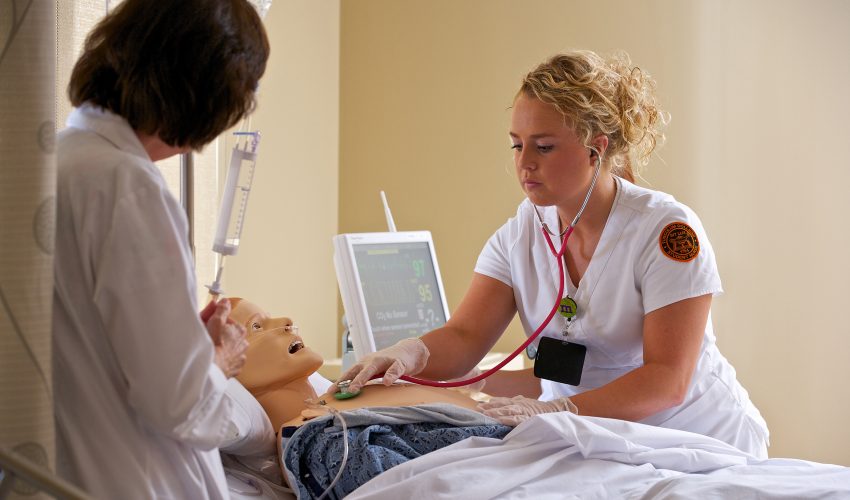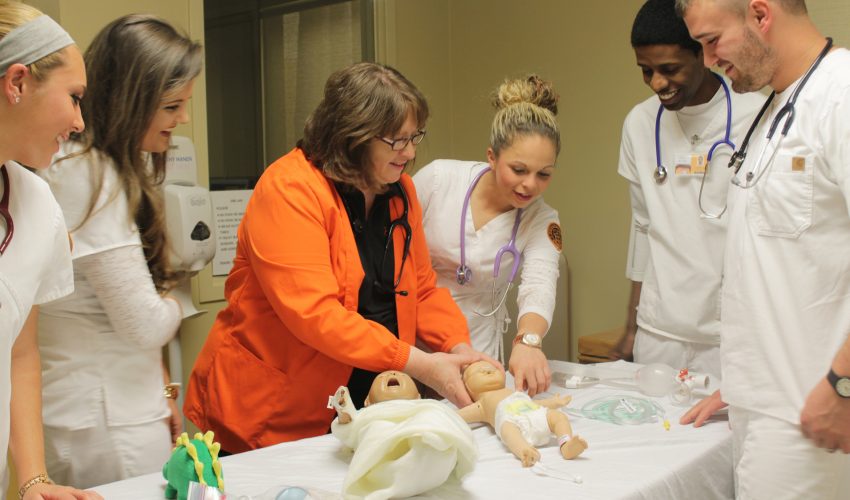The first thing she notices is he’s running a fever — he’s warm to the touch, sweating and having trouble breathing.
She takes his pulse; his heartbeat is irregular.
Then his face turns blue and he starts foaming at the mouth.
She’s uncertain of what to do next, but she’s running out of time.
She has to make a call.
“Pulmonary edema,” she says to her team. “We need to give him oxygen.”
The team proceeds with the treatment, administering oxygen and medication.
They monitor his vitals, but his breathing worsens — nothing is working. Eventually his heartbeat slows to a stop.
“Cardiac arrest,” says the teacher, stepping in and stopping the simulation. “The key was to catch the irregular heart rate changes and prevent further decompensation.”


Simulated scenario, real experience
And so a mistake that would have proven fatal in the real world is now just a memory, which the nursing students learn from and can recall should they ever face something similar.
That’s how things go at Tusculum College in Greeneville, where several state-of-the-art simulators allow future nurses to learn by making their own choices — even if those choices are wrong.
Simulations are run, recorded and reviewed by the class to ensure everyone knows what was done right and what could have been done better.
“It’s an incredible opportunity for students to engage in hands-on learning,” says Dr. Lois Ewen, dean of the School of Nursing, Health Sciences and Human Services at Tusculum College.
“In a clinical setting, the patient comes first, which means a student can’t always participate when we’re running a code for a heart attack, as an example. With the simulator, we can let them perform all the roles — give compressions, administer medications — and we can allow students to make mistakes, which we’d never be able to do otherwise.”
“Real emergencies are fairly scary events, and when you don’t get a lot of practice, you don’t have a lot of confidence or skill.”
“Simulation allows students to practice and gain confidence in their abilities.”
Getting that kind of experience is even more difficult when it comes to children.

Most kids are never ill enough to be admitted to a hospital, but nurses have to know how to treat them when they are.
Now, thanks in part to a $116,159 grant from the BlueCross Health Foundation, students have that chance.
In addition to the two adult simulators BlueCross partially funded in 2012, Tusculum now has a SimJunior (6-year-old child) and a SimBaby (9-month-old infant).
“Small children are most often admitted because of diarrhea and dehydration, and we can run both of those scenarios with the simulators,” says Ewen. “It’s so hard for students to get those interactions any other way.”
Almost human
To say the mannequins are realistic is an understatement.
Aside from standing or walking, they do everything a real human does: breathe, blink, sweat, have a seizure, go into cardiac arrest, tear up, salivate.
With 90 pre-made scenarios — think cystic fibrosis or sickle cell crisis — they can exhibit symptoms of heart, lung or bowel problems to a stunning degree of realism; their pupils even dilate.

Spreading the knowledge
The program’s benefits are obvious — the better prepared health care providers are, the better they can take care of patients — but Tusculum has found other ways to use the simulators to benefit the community:
- Students majoring in biology, physical education or athletic training use simulators to learn about human physiology.
- Trainers use them in disaster drills, on campus or in the community, to test crisis preparedness.
- Local hospital staff use them for skills updates, to see new procedures or processes demonstrated as they would be on a real patient.
- Schools bring them in to health fairs to teach kids about the human body and give them an up close look at what medical professionals do.
- Looking ahead, the team at Tusculum is also talking to first responders about the possibilities of using the simulators in training exercises.
“First responders receive a lot of training taking care of adults, but children are so different,” says Ewen, “so we’re talking to local first responder trainers about how to use our pediatric simulators to help crews maintain skills.
“It’s exciting to be able to use a technology we know works so well in new ways in the community.”


